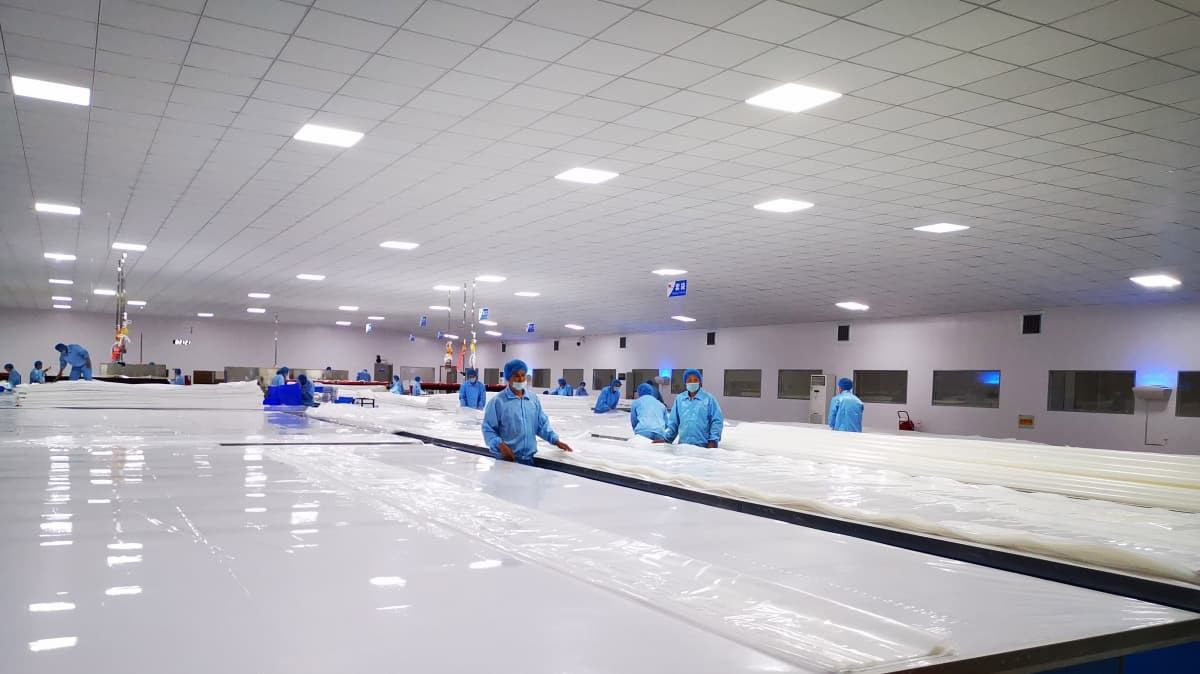In the latest installment of the “Bulk booze by sea” series, FreightWaves looks at transoceanic wine shipping amid the pandemic. Previous installments featured the early days of alcohol transport via tankers and the modern-era shift to alcohol in containers.
Lockdowns, lost jobs, lost vacations, the threat of dying from COVID, rabid political partisanship … it can all drive one to drink. It is, in fact, driving a lot of people to drink a lot more than they drank before, according to Damien McClean, CEO of SIA Flexitanks.
McClean would know. His company is the world’s third-largest provider of the flexible, single-use polyurethane bladders that allow bulk transport of wine via ocean shipping containers. From his office in Ireland, he has an insider’s view of how much bulk wine is moving around the globe on which routes.
McClean spoke at length with FreightWaves on Wednesday about his company’s experiences during the pandemic.
Beyond his insights on alcohol consumption, he described the changing dynamics in the flexitank industry and how COVID is complicating global supply chains.
Drinking more wine at home
Wine is shipped in ocean containers in either bottles or bulk flexitanks. By bottle, shippers can move 9,000 liters per twenty-foot container. By flexitank, 24,000 liters.
Flexitank wine is bottled at the destination and is generally of lower quality than wine bottled at the source. Wine shipped in bottles is sold more at restaurants and hotels, as well as liquor stores. Flexitank wine is more prevalent in grocery stores, and also at liquor stores and as house wines at restaurants.

Restaurant, bar and tourism restrictions are hitting bottled wine hard, but people are drinking more at home, boosting flexitank volumes. “There has been a huge increase in the demand for bulk wine,” reported McClean.
“Throughout the pandemic, we’ve seen people drinking a lot more wine at home,” he said. He believes they’re drinking as a defense mechanism and out of boredom. “They didn’t think this would go on this long. And if you’re pouring a measure of wine for yourself at home, just ask yourself: Is what you pour the same size you’d get in a restaurant?”
He estimated that there will be 2 million full flexitanks shipped globally this year, up 25% from 1.6 million in 2019, with about 300,000 of them carrying wine. SIA’s flexitanks for wine shipments look like they will be up more than 30% in 2020.
All clear in China, wine-exporting countries
SIA has had front-row seats for the coronavirus crisis since the very beginning.
All of its flexitanks are manufactured at a factory in Qingdao, China. The site was shut for several weeks after Chinese New Year in February when China locked down after the initial Wuhan outbreak. “But we were back up and running in China quickly,” noted McClean.

Today, SIA staff in China report a starkly different COVID landscape than is seen in the U.S. and Europe. “My colleagues tell me life is going on as normal now. They can go to restaurants and cinemas and can travel within China as they wish.”
In terms of getting wine from wineries into flexitanks and then getting containers to ports for export, McClean saw almost no disruptions this year, despite major lockdowns in the U.S. and Europe. South Africa, where there were brief export restrictions, was the only exception.
“Thankfully, delivering alcohol is considered an essential service. Even in Italy and Spain when things were at their worst, we were able to keep moving,” he recounted.
Getting flexitanks and wine to destinations
But to get the wine out of wine-producing nations, SIA must first get its flexitanks from China to those nations.
SIA transports empty flexitanks in batches of 155 flexitanks per 40-foot high-cube container. It uses hubs in Rotterdam, The Netherlands; Port Klang, Malaysia; and Houston.
Forty-foot high cubes are in extremely high demand for Chinese consumer-goods exports to the U.S. SIA has to compete for those boxes. It is also seeing major delays at transshipment ports and in Long Beach, California.
“To counteract that, we’ve had to increase our inventory levels at all of our hubs to factor in the delays we know are coming,” McClean explained. “We’ve had to invest in higher inventory costs.”
This same pattern is being seen among many other shippers. It’s one reason for today’s massive trans-Pacific volumes. Heightened delays mean companies need more backup supplies, which means they need higher overall volumes, which further heightens delays, which creates demand for more backup supplies.
“Instead of taking a month to get [from China] to Australia, it’s taking two months. You make a booking and then you keep getting bumped. And delays coming into Long Beach are especially bad. Even after you get there, you sit for days, then there’s a problem getting a chassis, and delays getting onto the rail. So, we’ve just had to consistently build up our inventories.”
“I expect it [congestion] will be crazy all the way until March, after Chinese Lunar New Year,” he predicted.
On a positive note, the wine exporters themselves are not being hit by container shortages. Due to weight restrictions, almost all wine shipped using flexitanks is transported in 20-foot containers, which are in much less demand than 40-foot high cubes.
Big consolidation in flexitank sector
As COVID pushes up demand for flexitanks, the sector itself is consolidating.
The two largest flexitank players in the world are Germany-headquartered Hillebrand and U.K.-headquartered Braid. Hillebrand announced in October that it was acquiring Braid. They will be run separately for now but will ultimately merge.
“It’s a big deal,” commented McClean of the takeover. “It has raised a few eyebrows. I mean, the word ‘monopoly’ springs to mind because the two biggest companies are merging.”
However, he believes No. 3 SIA will actually benefit from the deal.
He explained that both Hillebrand and Braid are freight forwarders. SIA is not. “Some people who use Braid wouldn’t use Hillebrand. And some use Hillebrand because they wouldn’t use Braid. So, there are people who ship in flexitanks who are not comfortable with this [consolidation] and a lot of them are actively looking for alternatives. We see exciting opportunities for us, without a doubt.”
What’s next for bulk wine shipping by sea?
Market developments in 2020 have been driven by the coronavirus. With a vaccine coming in 2021, won’t dining in restaurants and drinking in bars normalize, and tourists return to hotels? Won’t this bring consumption back toward higher-end bottled wine at the expense of bulk flexitank wine?
McClean doesn’t think so. “We believe there’s going to be a huge economic stimulus next year. It’s not going to be the Roaring ’20s, but people will be spending more and demand for wine will increase [for both flexitank and bottled wine transport].”
He also thinks the drinking-at-home behavior induced by COVID restrictions is entrenched. That would keep purchases from groceries stores and liquor stores — and thus flexitank volumes — high.
“It’s sort of like what we found here in Ireland after they changed the laws so there was no smoking allowed in pubs. People started staying at home and the pubs never really recovered.”
In the same way, he foresees a continuation of “the lifestyle of picking up bottles of wine and having some friends over. And if you are having people ’round and you’re going to consume in quantity, you will be buying a lot more $10 bottles of wine [that came overseas in flexitanks]. So, quantity over quality.
“It sounds like I’m trying to encourage a nation of alcoholics … but I don’t see that market dropping away.” Click for more FreightWaves/American Shipper articles by Greg Miller
MORE ON ALCOHOL SHIPPING AND FLEXITANKS: Bulk booze by sea: The past: see story here. Bulk booze by sea: The present and future: see story here. Inside a Chinese factory in the time of COVID: see story here.







